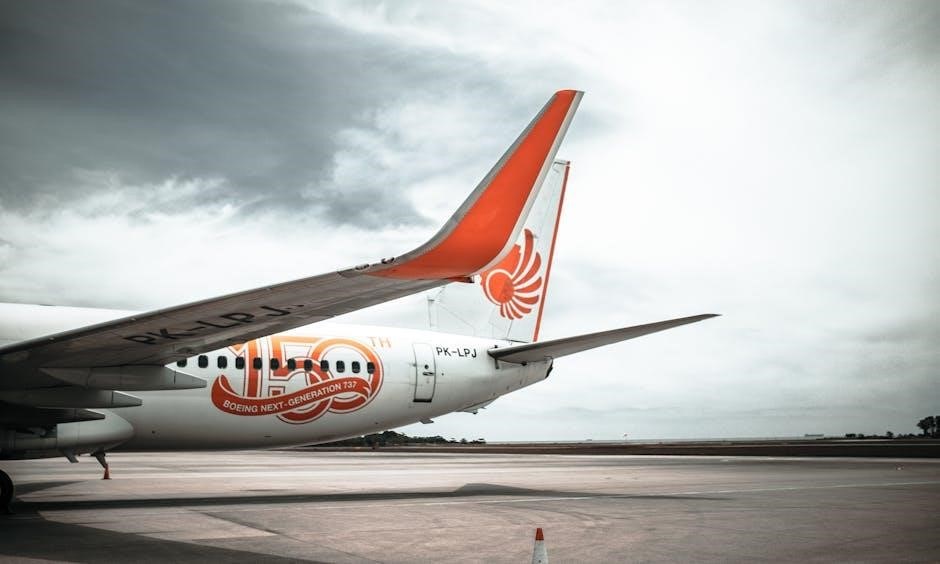The ITE Trip Generation Manual is a cornerstone document for transportation planning, providing comprehensive guidelines and methodologies for estimating trips generated by various land uses.
It serves as a critical resource for professionals to understand travel demand, supporting informed decision-making in urban and transportation infrastructure development.
1.1 Overview of the Institute of Transportation Engineers (ITE)
The Institute of Transportation Engineers (ITE) is a professional association dedicated to advancing transportation engineering and planning globally.
Founded in 1930, ITE serves as a hub for professionals, offering resources, standards, and education to enhance mobility and safety in transportation systems worldwide.
1.2 Importance of Trip Generation in Transportation Planning

Trip generation is foundational in transportation planning, determining how land uses produce trips, guiding infrastructure design, and ensuring efficient movement of people and goods.
Accurate trip generation analysis informs policy decisions, optimizes resource allocation, and supports sustainable urban development, making it critical for effective transportation systems.

The Four-Step Transportation Forecasting Process
The four-step process includes trip generation, distribution, mode choice, and route assignment, providing a structured approach to forecasting travel demand and planning transportation networks effectively.
2.1 Trip Generation as the First Step
Trip generation is the foundational step in transportation forecasting, estimating the number of trips produced by and attracted to land use activities. It calculates trip rates based on factors like land use type, household characteristics, and employment levels. This step provides the baseline data for subsequent steps, ensuring accurate forecasts for transportation infrastructure planning. Open-source tools like TRIPCAL5 enhance this process with advanced methodologies.
2.2 Subsequent Steps: Trip Distribution, Mode Choice, and Route Assignment
Following trip generation, trip distribution identifies where trips start and end, connecting origins to destinations. Mode choice determines the transportation method used, while route assignment allocates trips to specific routes. Together, these steps create a comprehensive travel demand model, guiding transportation planners in designing efficient networks and addressing mobility needs effectively.

Key Components of the Trip Generation Manual
The manual outlines land use classifications, trip rates, and statistical models, enabling accurate predictions of travel demand based on socio-economic and spatial data.
3.1 Land Use and Activity-Based Approaches
Land use classifications within the manual provide a framework for estimating trips based on development types, such as residential, commercial, or industrial areas.
Activity-based approaches focus on the timing and sequencing of daily activities, offering insights into how land use influences travel patterns and demand across different periods.
3.2 Data Collection and Analysis Methods
Data collection involves gathering information on traffic counts, land use characteristics, and trip-making behavior through surveys and observations.
Advanced analysis methods, such as statistical modeling and software tools like TRIPCAL5, enable precise estimation of trip generation rates, supporting accurate transportation planning and decision-making.

TRIPCAL5: A Tool for Trip Generation Analysis
TRIPCAL5 is a technical tool designed to assist in trip generation analysis, supporting transportation planners with accurate predictions and informed decision-making.
It provides comprehensive documentation, including default models, to enhance the precision of trip generation estimates for various land use scenarios.
4.1 Features and Functionality of TRIPCAL5
TRIPCAL5 offers advanced trip generation analysis, including default models and technical documentation, enabling precise forecasting for transportation planning.
Its functionality supports data processing, model application, and scenario analysis, making it a robust tool for estimating travel demand in various land use contexts.
4.2 Application in Modern Transportation Planning
TRIPCAL5 is widely applied in contemporary transportation planning to estimate travel demand accurately, supporting land use and infrastructure decisions.
Its integration with modern tools enhances scenario analysis, enabling planners to address emerging challenges like multimodal transportation and sustainability in urban development.

Critiques and Challenges in Trip Generation
Critics highlight limitations in trip generation models, such as outdated assumptions and lack of integration with emerging transportation modes.
Addressing these challenges requires innovative approaches to enhance accuracy and adaptability in modern planning contexts.
5.1 Shoup’s Critique of Transportation Planning Practices
Shoup’s critique highlights limitations in conventional transportation planning, emphasizing the need for more nuanced approaches beyond traditional trip generation methods.
He argues that current practices often prioritize car-centric development, neglecting land use changes and alternative transportation modes, urging a shift toward more integrated and sustainable planning strategies.
5.2 Addressing Limitations in Trip Generation Models
Traditional trip generation models often oversimplify travel behavior, failing to account for emerging trends like remote work and shared mobility.
Advancements in data collection and analytic techniques are helping to address these limitations, enabling more accurate predictions and fostering inclusivity of diverse transportation modes.

Case Studies and Practical Applications
Case studies demonstrate the practical application of trip generation principles, such as Vermont’s Trip Generation Manual and the Traffic Impact Sketch Planning (TISP) model.
6.1 The Vermont Trip Generation Manual
The Vermont Trip Generation Manual offers a tailored approach to estimating travel demand, reflecting local land-use patterns and transportation infrastructure. It incorporates data from various sources to provide accurate trip generation rates for different development types. This manual is a valuable resource for planners, ensuring that transportation projects align with regional needs and policies effectively.
6.2 Traffic Impact Sketch Planning (TISP) Model
The Traffic Impact Sketch Planning (TISP) model is a simplified approach for estimating travel demand generated by major land-use developments. It provides a quick and practical method for assessing traffic impacts early in the planning process. By focusing on key variables, the TISP model helps planners and engineers evaluate potential transportation needs effectively, ensuring efficient and sustainable infrastructure design.

Estimating Non-Motorized Travel
Estimating non-motorized travel is crucial for sustainable transportation planning, involving methods to count pedestrian and bicycle trips and integrate them into overall trip generation analysis.
7.1 Methods and Tools for Pedestrian and Bicycle Travel
Estimating pedestrian and bicycle travel involves counting techniques, surveys, and modeling approaches to capture non-motorized trips accurately.
Tools like manual counts, automated counters, and GIS-based models are widely used, as outlined in resources like the Turner-Fairbank Highway Research Center’s guidebook on non-motorized travel methods.
7.2 Integration with Overall Trip Generation Analysis
Integrating pedestrian and bicycle travel data into trip generation analysis enhances comprehensive transportation planning.
By combining non-motorized travel estimates with traditional trip generation models, planners achieve a more holistic understanding of transportation demand, ensuring sustainable and multimodal infrastructure development, as emphasized in resources like the Vermont Trip Generation Manual and Traffic Impact Sketch Planning models.

Future Directions in Trip Generation
Future directions include leveraging advanced data technologies, integrating AI, and focusing on sustainable, multimodal transportation solutions to enhance accuracy and environmental impact in trip generation models.
8.1 Advances in Data Collection Technologies
Emerging technologies like AI, IoT sensors, and big data analytics are revolutionizing trip generation by enabling real-time data collection, improving accuracy, and providing deeper insights into travel patterns.
These tools allow planners to capture nuanced traveler behaviors and integrate diverse data sources, enhancing the precision of transportation models and supporting smarter, data-driven decision-making processes.
8.2 Incorporating Emerging Modes of Transportation
Modern transportation planning increasingly integrates emerging modes like electric vehicles, shared mobility services, and autonomous vehicles into trip generation models to reflect evolving travel preferences and technologies.
These innovations require updated methodologies to accurately capture their impacts, ensuring that trip generation analyses remain relevant and effective in shaping future transportation systems.
The ITE Trip Generation Manual remains a foundational resource for transportation planning, offering essential methodologies for forecasting travel demand and shaping infrastructure development.
Its principles continue to evolve, addressing emerging transportation modes and technologies, ensuring relevance in modern urban planning and policy-making.
9.1 Summary of Key Concepts
The ITE Trip Generation Manual provides methodologies for estimating travel demand, emphasizing land use and activity-based approaches. It integrates data collection tools like TRIPCAL5, addressing critiques and incorporating non-motorized travel; Case studies, such as Vermont’s manual and TISP models, demonstrate practical applications. Looking ahead, emerging technologies and modes reshape trip generation, ensuring its relevance in modern planning.
9.2 The Role of the ITE Trip Generation Manual in Modern Planning
The ITE Trip Generation Manual remains pivotal in modern transportation planning, offering standardized methods and tools like TRIPCAL5 to estimate travel demand accurately. It supports sustainable and equitable urban development by integrating emerging technologies and modes, ensuring adaptability to evolving transportation needs. The manual’s practical applications, such as in Vermont’s manual and TISP models, highlight its enduring relevance and influence in shaping efficient transportation systems.

